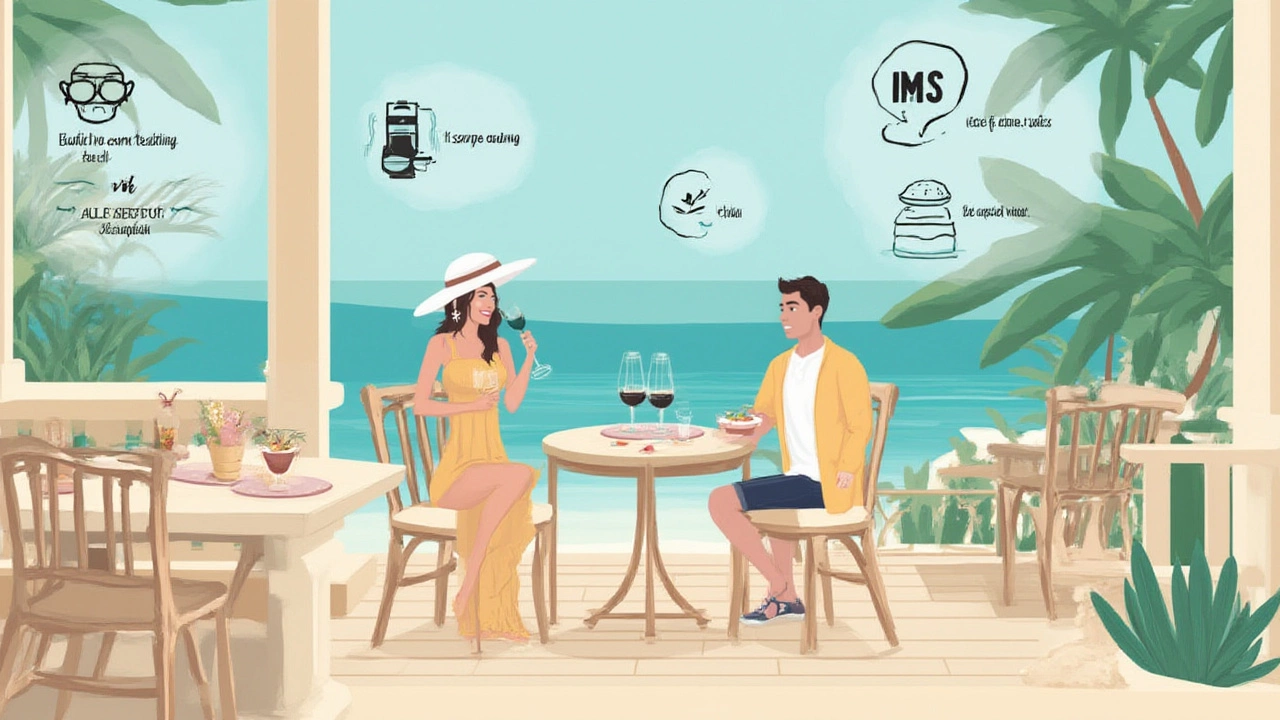So, you book an all-inclusive resort. It sounds magical, doesn’t it? Wandering up to a buffet at midnight for a second dessert, poolside tacos at noon, and drinks that just keep coming. But how unlimited is all-inclusive resorts dining, really? Could you get away with ten pizzas or demand breakfast at 2 a.m.? The truth is sneakier (and more interesting) than most people expect.
The Myth of Limitless Food: What All-Inclusive Really Means
The phrase "all-inclusive" triggers dreams of endless food and bottomless drinks. People picture themselves living like royalty—never worrying about the bill, sampling everything on the menu, piling up plates like it’s a TikTok challenge. But is it truly "eat as much as you want, anytime"? The answer is a little yes, a little no.
Most resorts really do offer abundant food within specific time slots and restaurants. There are usually three meals a day—breakfast, lunch, and dinner—served in big buffets or expansive dining rooms. In some places, there are snack bars and cafés open in between. Yes, you could linger at lunch and fill five plates. You could pop by for another round of dessert. Yet, most have boundaries. Midnight cravings? Some places have 24-hour snack shacks or room service, but don’t expect the entire buffet to stay open all night. Often, select venues are open during off-hours and offer a trimmed-down menu of favorites.
What about à la carte restaurants? That’s where the limits sneak in. While buffets are usually a free-for-all, specialty restaurants often require reservations—sometimes with restrictions. You might get three dinners at these fancier places during a seven-day stay. If you show up every night for sushi or steak, chances are they’ll say, "Sorry, you’ve reached your limit." They want to give everyone a turn, and the cost of high-end ingredients forces their hand.
Buffets, Snack Bars, and Room Service: What's Actually Included?
The classic resort buffet is where all-inclusive really shines. Breakfasts bursting with tropical fruits, omelet stations, endless pastries. Lunches roll out burgers, salads, seafood, tacos. If you want to try everything, go wild—nobody keeps track of how many plates you grab. Still, most people end up eating only a fraction of what’s on display because the variety is overwhelming. Now, the quality varies by resort and country. Five-star resorts in Cancun or Punta Cana tend to serve up fresh sushis and grilled lobster tails, while budget-friendly options may focus on crowd-pleasers like pasta and chicken.
Ever noticed how the best buffets have lineups at the carving station or fresh pizza oven? Resorts put their best dishes front and center, but not always in unlimited amounts. For instance, crab legs and perfectly seared steaks might disappear within an hour, with servers keeping an eagle eye so guests don’t hoard. If you want second helpings of the hot-ticket items, it pays to arrive early. Not everyone knows this, but weekday menus often differ from weekend spreads, which are traditionally the fanciest.
Snack bars and grills fill the hunger gaps between main meals. You’ll find nachos, fries, sliders, and pizza almost around the clock near the pool or beach. Kids love these places for their never-ending soft-serve and hot dogs, while adults often sneak over for late-afternoon bites after a swim or tennis match. At higher-end resorts, expect fancier bites like sushi rolls, ceviche cups, or quality cheese plates.
Room service—now there’s where things get tricky. Some all-inclusives offer free room service 24 hours a day. Others, especially budget or mid-range resorts, may offer it only during set hours or charge a delivery fee. Menus for in-room dining are often much shorter—think club sandwich, pasta, or a burger—rather than the full buffet experience. Guests sometimes mistakenly expect to order anything from any restaurant to their room, but what you get is often a slimmed-down, simpler selection.

Drinks and Extras: What’s Bottomless and What Costs More?
Drinks are where people either fall in love with all-inclusives or get frustrated by hidden limits. The promise is unlimited cocktails, wine, beer, juice, and coffee. At most resorts, yes, you can sip a mojito at the pool, have wine at every meal, and grab a coffee before your morning walk. But not every drink is created equal.
The basic beer and house wine are usually free-flowing. Cocktails are included, but the choice of liquors might be restricted. For example, you can get a piña colada, but want top-shelf whiskey or premium tequila? That’s when you’ll be asked to upgrade (and pay extra).
Minibars in your room might be stocked daily with soda, water, what some call “well” spirits, and beer. Fancy chocolates or a bottle of Champagne are usually not free and come with a pricey sticker. Tip: Always check what’s actually included. Some resorts include one or two specialty dining nights per week, but extra lobster night or wine tasting? That’ll show up on your bill.
Some resorts limit alcoholic beverages for guests who appear heavily intoxicated—a practice that’s stricter in the Caribbean than, say, Spain. Bartenders can refuse service if someone’s had too many, but this isn’t common unless things get rowdy. Also, drinks at the nightclub or a la carte bars sometimes cost more or require a pre-paid package, especially after midnight.
The Hidden Rules: Reservations, Dress Codes, and Unwritten Limits
This is where a lot of first-timers get tripped up. While buffets may be a relaxed come-and-go situation, à la carte restaurants are a different story. You’ll often need to reserve in advance. Some resorts have smartphone apps that open up reservation slots at a certain hour—think 8 a.m. sharp for steakhouse bookings. Miss the booking window, and you might be stuck with buffet every night.
Many resorts limit how often you can eat at specialty spots. For example, Sandals Resorts typically allow unlimited à la carte bookings, but others restrict you to three reservations per week for their upscale dining rooms. High-end options (like Nobu-style sushi) are either included or cost extra, depending on your package type. If you’re aiming for a romantic dinner, always double-check those reservation policies when you arrive—or even before during check-in.
Dress codes are real and sometimes strictly enforced at specialty restaurants. No flip-flops, beachwear, or sleeveless shirts for men. Some even require long pants at dinner. If you show up in a T-shirt, you’ll often be sent back to your room for a quick change. Buffets are way more relaxed. You can show up in casual clothes or swimsuit cover-ups for breakfast and lunch, but even here, no dripping swimwear is allowed inside.
Unwritten limits pop up at the bar, too. Bars will serve you two drinks at a time, not five. The aim is to keep things friendly and fair, not to encourage binge drinking. It might also explain why drinks are usually a little weaker than at a regular bar. Resorts balance generosity with crowd control—the philosophy is keep everyone happy, not out of control.

Tips for Making the Most of All-Inclusive Dining
Now, don’t get me wrong. All-inclusive resorts are a foodie playground if you know how to play the game. Want to maximize your experience? Here’s what savvy travelers do—and what the resorts probably won’t tell you.
- Arrive early at the most popular buffets and specialty restaurants. That’s when you’ll get first dibs on the best dishes before they’re gone.
- Check your daily activities guide. Some resorts have theme nights (Mexican fiesta, seafood night, steakhouse) and pop-up food stations.
- Say hello to the chef or front desk staff. Friendly guests sometimes score off-menu treats or better table choices.
- Check if your resort uses a bracelet system. Some bracelets offer higher-tier inclusions—for example, premium drinks or extra à la carte dinners.
- Download the resort’s app (if they have one) to reserve restaurants fast, order room service, and see which snack spots are open late.
- If you’re vegan, gluten-free, or have food allergies, let the staff know early. They’re usually ready to whip up something fresh if you ask in advance.
- Tip the waiters and bartenders. This isn’t mandatory, but a small tip often brings quicker service or a bonus drink. U.S. dollars go further than coins or local small change.
- Order small portions. It’s tempting to fill your plate, but the best trick is trying a bit of everything instead of one giant heap.
- Watch the daily schedule. Some resorts shut down buffets for cleaning between meals, so snack bars become your friend.
- Ask about chef’s specials or “hidden” menus at specialty restaurants. Chefs occasionally prepare surprise courses for guests who are curious and polite.
Still not convinced? Here’s a quick glance at what’s often included versus extra at typical resorts.
| Included | Usually Extra |
|---|---|
| Buffets (all meals) | Premium steaks, lobster, imported wines |
| Snack bars and poolside grills | Spa treatments, private dining on the beach |
| House alcoholic beverages & cocktails | Top-shelf liquor, champagne, craft cocktails |
| Most à la carte dinners (reservation needed) | Additional à la carte nights after your quota |
| Room minibar (replenished daily) | Special room service items, minibar upgrades |
| Some room service options | Late-night room service at some resorts |
If you’re a social eater, buffets let you graze with friends and family at your pace. Traveling with kids? The endless soft-serve and make-your-own tacos are lifesavers. Craving privacy? Order room service and watch the sunset from your balcony—but read that menu carefully.
Here’s one thing you can count on: all-inclusive resorts make it easy to try new foods without worrying about the bill, or who picks up the check. It really is a chance to relax and enjoy. Just remember—there are still a few fine print limits, both posted and unwritten. Knowing where to look (and how to ask) can be the difference between a regular vacation and a seriously unforgettable eating adventure.
